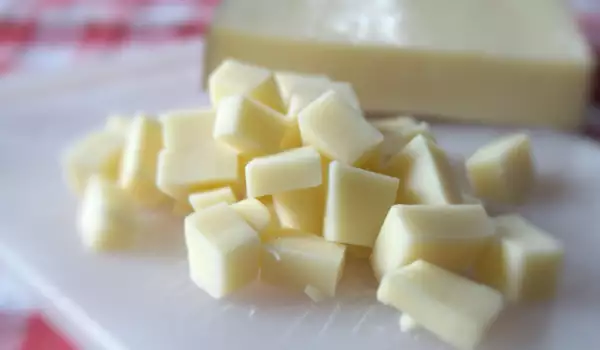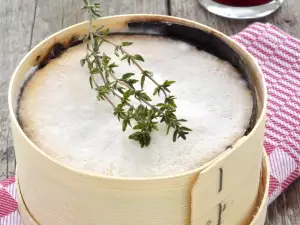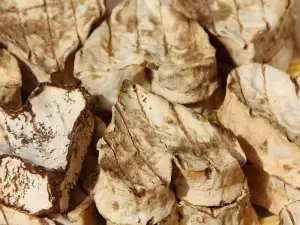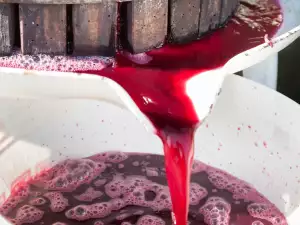Fontina is a type of cheese originating from Italy. It is made from select high fat cow's milk. It is characterized by a thin but compact crust that is either brownish, golden or pinkish. The inside of the dairy product is soft, distinguished by a yellowish coloration and riddled with small holes all over. Besides by its visible characteristics, you will recognize the cheese by its fatty taste, containing light grassy nuances as well. The aftertaste is fatty too. When tasting Fontina, you are taken to a garden verdant with herbs and fresh green grass.
History of Fontina
Fontina is an Italian cheese with a rich history. The preparation of this type of cheese has turned into a real tradition. Records indicate that it has been made in Valle d'Aosta since the 12th century. However, it received its modern name much later - in the 17th century. The first mentioning of the cheese in the writings of the Gran San Bernardo monastery also date back to that time. Since then its fame has been spreading far and wide. The name of the cheese has been interpreted in various ways.
Some believe that that was how they labeled the best pastures in the region, others say that the word describes the most characteristic quality of the cheese, that being the way it melts. This conjecture comes from the fact that the word
Fontina in Italian is translated as "melting". Slowly but surely, Fontina secured its place at every chef's table.
Composition of Fontina
Fontina contains saturated fats, polyunsaturated fats, monounsaturated fats, valine, alanine, arginine, glycine, lysine, proline, serine and others. This type of cheese is a source of iron, calcium, phosphorous, copper, selenium, manganese, magnesium. Further, it has vitamin A, vitamin B1, vitamin B2, vitamin B3, vitamin B6, vitamin B9, vitamin B12, vitamin E and vitamin K.
Production of Fontina
Fontina is classified as a semi-hard cheese. As mentioned, it is characterized by its yellow to golden crust and soft inside. What needs to be mentioned is that the true character of the cheese is revealed during preparation of the product. The milk chosen for the cheese also plays a key role since it is obtained from a special breed of cattle.
As a rule, Fontina must age at least 3 months at a temperature of about 50°F (10 °C), with some cheeses aged longer. As such, there are varying colors and aromas. The difference immediately affects the price since logically, products aged longer are of higher value.

Choosing and Storing Fontina
Aged cheese that is ready for distribution in supermarket chains is in the shape of a pita. It has a diameter of up to 17 3/4″ (45 cm) and height of up to 4″ (10 cm). The cheese offered in stores has a special seal guaranteeing its designation of origin and quality - FONTINA DOP ZONA DI PRODUZIONE • REGIONE AUTONOMA VALLE D'AOSTA. This means that the product was made in Valle d'Aosta. If this seal is missing, the quality of the given Fontina is questionable.
When choosing Fontina, look at its color and general appearance. If it is different from anything listed above, best not to buy it. By pressing on it lightly you can also check its consistency. As a rule, Fontina is springy and does not crumble. After you buy the cheese, store it only in the refrigerator.
Cooking with Fontina
The distinct soft and gentle taste, as well as the slightly spicy aromas, are qualities not to be passed by. Fontina easily manages to find its place in the kitchen. When the cheese is younger it is best to use it without heat treatment. Even if you serve it on its own, cut into pieces, you will definitely impress your guests. Generally, sliced pieces of Fontina are served as appetizers in combination with red wine. Well aged cheese is used in a number of recipes that require heat treatment. It is usually used to prepare fondue.
Now let us offer you a fondue recipe with which to spice up your weekly menu:
Ingredients: 19 oz Fontina, 1 1/2 cups white wine, 3-4 tsp potato flour, black pepper, nutmeg, cumin.
Preparation: Pour the white wine into a pot on the stove on low heat. Once the alcohol heats up, add the Fontina to it. Stir the ingredients until they are blended completely. To thicken the mixture even more, add the potato flour dissolved in a little wine beforehand.
At the end, add the spices - sprinkle with black pepper, nutmeg and cumin. Of course you can go with other spices as long as you think they would go well with the fondue. Once the specialty is ready, remove it from the heat. After serving, dip pieces of bread in it using fondue forks and enjoy.
The delicate and refined taste of Fontina means it can be included in many other recipes. The dairy product is used in soups, sauces, salads, pastas, oven bakes. It can be combined with all kinds of fresh vegetables and with other cheeses, including Taleggio, Gorgonzola, Parmesan.
Benefits of Fontina
Even though Fontina is a remarkably appetizing and aromatic cheese, it is not famous for these qualities alone. The popularity of the dairy product is owed to a great extent to the fact that it possesses a significant quantity of vitamins and minerals, which we need to enjoy prime health.
The cheese stabilizes cholesterol levels in the blood, as well as water balance. Eating Fontina strengthens the bones and regenerates the skin, hair and nails. Consumption of this cheese also has a beneficial effect on the cardiovascular system.












Comments